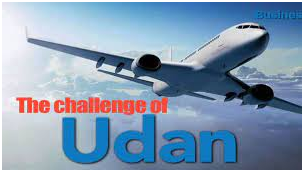Only 1 of 4 UDAAN routes survive on completion of 3 years
What is the news:
- Only one out of four routes under the low-cost flying scheme called UDAN have survived after completing the government’s subsidy period of three years, according to information shared by the Ministry of Civil Aviation before a Parliamentary panel.
- “Of the 94 RCS-Udan routes that have completed 3-year tenure till 30.11.2021, only 22 routes are in operation,” the Ministry told the Parliamentary Standing Committee on Transport, Tourism and Culture which tabled its report in Parliament last week.
What is the UDAAN schem:
- Nearly five years ago, Prime Minister Narendra Modi launched the first flight under Ude Desh Ka Aam Nagrik (UDAN) scheme, also known as regional connectivity scheme (RCS).
- The aim of the scheme was to take flying to the masses and improve air connectivity to tier-2 and tier-3 cities.
- The scheme is aimed at enhancing connectivity to remote and regional areas of the country and making air travel affordable.
- It is a key component of Centre’s National Civil Aviation Policy led by Prime Minister Narendra Modi and launched in June 2017.
- The scheme is jointly funded by the central government and state governments.
- Under the scheme, airlines have to cap fares at ₹2,500 per seat per hour of flight for 50% of the seats in a plane for which they receive a viability gap funding (subsidy) from the government along with some other benefits.
- The government expected that after the expiry of the three-year subsidy period, airlines would be able to sustain the routes without outside support.

- The scheme document says the key guiding principle is to encourage “sustainability of operations under RCS in the long term — such that the connectivity established is not dependent on VGF in perpetuity”.
- It also recognises that select areas may need funding support for longer periods.
Important :
- While some airlines like the Hyderabad-based TruJet have approached the government for an extension of the subsidy period, their request has been declined but the government has offered to extend certain benefits for one year, the Ministry told the Parliamantary panel.
- It is learnt that these benefits include parking and landing charges, electricity charges, and route navigation and facilitation charges on a discounted bases.
- Since 2017, there have been seven rounds of bidding for routes during which 948 have been awarded to airlines and helicopter operators. Of these 403 routes have commenced operations. Of the 154 unconnected airports (including 14 water-aerodromes and 36 heliports have been identified for operation of RCS flights) planned to be revived, 65 have resumed flights.
- The government has also told the committee that 300 routes “have been affected due to poor demand on account of Covid-19 pandemic situation”.
- Officials of the Ministry of Civil Aviation say this means that the routes have seen demand plummet in view of which the government has allowed airlines to reduce their frequency to 60%, on the condition that the subsidy too will be cut proportionately.
Several challenges
- Asked why all the awarded routes have not commenced flights, the Ministry has cited several challenges. These include difficult airline business which has low yield and high operating costs, lack of slots at congested airports like Delhi and Mumbai, non-availability of smaller planes and maintenance issues which require procurement of spare parts from abroad.
- The government has also said there have been delays in completing airport development work due to lack of funds and non-availability of land.
Key features of the scheme:
- Airlines are awarded routes under the programme through a bidding process and are required to offer airfares at the rate of ₹2,500 per hour of flight.
- At least 50% of the total seats on an aircraft have to be offered at cheaper rates.
- In order to enable airlines to offer affordable fares they are given a subsidy from the Government for a period of three years.
What the scheme have achieved :
The achievements under the UDAN scheme and measures to boost civil aviation sector in the country are as under:
- Till date, out of 948 valid routes, 403 routes involving 65 airports (including 8 heliports & 02 water aerodromes) have been operationalised across the country under UDAN.
- Approximately 86.05 lakhs passengers have travelled on UDAN flights since its commencement till 09.01.2022.
- UDAN has transformed the way people travel in Tier-2 and Tier-3 cities. Regional airports like Jharsuguda, Kishangarh, Belgaum, Darbhanga, etc. have been witnessing exponential growth in air traffic.
- The scheme offers a unique opportunity to a common person to fly at an affordable price, for which the Government has capped the Airfare for the seats where VGF is extended to airlines under the RCS scheme.
- UDAN scheme has sparked significant increase in helicopter services in hilly areas and islands through use of heliports.
- The linkage between the Civil Aviation Sector and Economic Growth is well recognized. International Civil Aviation Organization (ICAO) study shows that the air connectivity has an economic multiplier of 3.1 and employment multiplier of 6.1.
- COVID guidelines/protocols for the Airline are framed in consultation with Ministry of Health & Family Welfare (MoHFW) and Ministry of Home Affairs (MHA) to boost confidence of the air travellers during COVID-19 pandemic.
- The other steps include e-boarding, web check-in, contactless dropping of baggage, etc.
Subscribe
0 Comments





